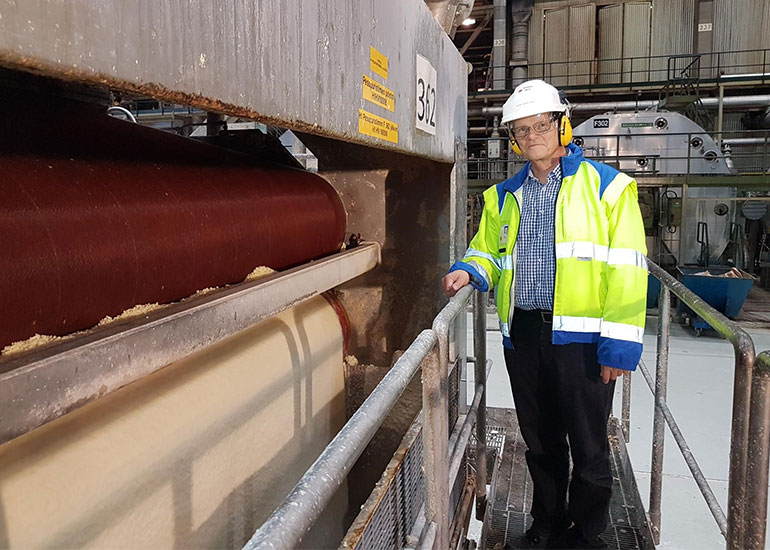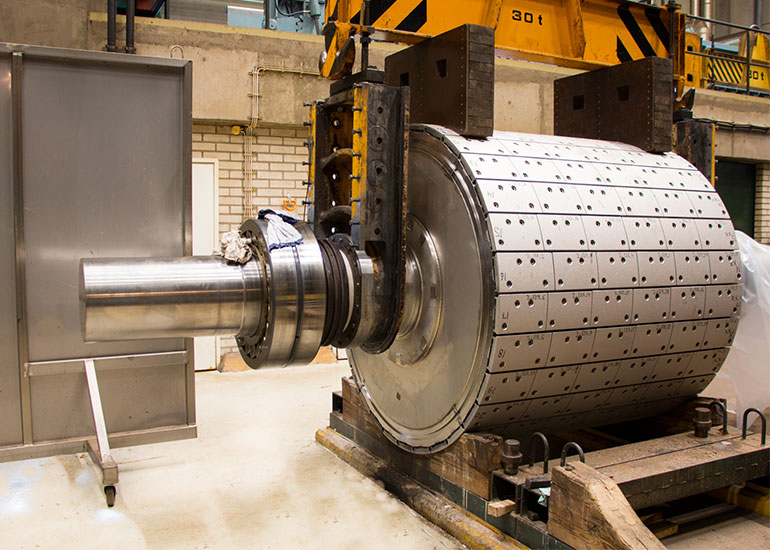At our Anjala Mill in Finland, our employees have recommended and carried out several changes over the past ten years that have improved the mill’s energy efficiency. Together with Stora Enso’s Ingerois board mill, Anjala paper mill forms a large mill integrate that uses large amounts of electricity.
“We need to use a lot of electricity to ensure a steady production of paper and board, so direct reductions in electricity use are challenging,” says Risto Mänttäri, Engineering Manager at Anjala Mill. “But we’ve found many ways to be more energy efficient. After years of adjusting settings, removing unneeded equipment, and improving processes, we asked ourselves: what else could we do to save energy and reduce emissions?”
 Risto Mänttäri has seen many improvements in energy efficiency during his years at Anjala paper mill.
Risto Mänttäri has seen many improvements in energy efficiency during his years at Anjala paper mill.
Hunting for new technology
“Knowing that modern technology that uses electricity efficiently would be the best way to go, we went on a hunt for new technological innovations,” says Aki Aaltonen, Production Manager at Anjala Mill. “In 2014, we found Galileo, a new energy-efficient way to make mechanical pulp.”
Unlike chemical pulp made at pulp mills, mechanical pulp is a high-yield mass that is traditionally created when wood is ground against a large rotating stone. This is the part of the process that consumes the most electricity.
“Galileo is an all-steel cylinder construction with small synthetic industrial diamonds attached to metal plates on its surface,” says Olli Tuovinen, Development Manager at Valmet, the company behind Galileo. “This makes Galileo more durable and more energy efficient than a traditional pulp stone. When the diamond coating on the metal plates wears down, we replace the plates with new ones and reuse the old ones several times.”
The Anjala Mill energy team turned to Stora Enso’s energy efficiency fund. Every year since 2008, the fund has earmarked about EUR 10 million to support the strategic energy efficiency work done at our mills.
“Over the years, the fund has supported dozens of projects that improve Stora Enso’s group-wide energy efficiency,” says Heinz Felder, Head of Investments and Energy at Stora Enso. “Projects funded in 2017, for example, will eliminate over 24 000 tonnes of annual fossil CO2 emissions.”

Synthetic industrial diamonds are attached to the metal plates on the surface of a Galileo cylinder.
A cylinder of energy savings
With funding granted from the energy efficiency fund, the first Galileo cylinder arrived at the Anjala Mill in the fall of 2015. There were some initial challenges to tackle, such as finding the perfect diamond coating for the mill integrate’s purposes – coated magazine paper needs a different combination of grinding surfaces than the pulp used to make book paper and board.
“After we learned how to optimise the first cylinder’s operation and achieved good results, we decided to apply for more funding to replace another pulp stone,” says Aaltonen. “Today, we have four cylinders in use – one of them makes mechanical pulp specifically for board, the first of its kind in the world. Another two will be installed by the end of 2018; at that point, about 70% of our mechanical pulp will be made with Galileo cylinders.”
The gradual switch to the cylinders has brought about exciting results. The Anjalankoski mill integrate is now using 25% less energy in the grinding and refining phase compared to before the first cylinder was installed. After all six cylinders have been installed, the savings in energy use will be about 50 000 MWh annually – that’s roughly a 5 000-tonne reduction in CO2 emissions every year.
“We knew to expect the reduction in electricity consumption,” says Aaltonen. “But as a pleasant surprise to both Valmet and us, we discovered that the plate we’re using allows us to work with frozen wood without compromising pulp quality – that’s a major improvement compared to traditional pulp stones. In Finland, where wood is frozen for 2-3 months out of the year, this is a welcome benefit.”
Sometimes it may be hard to see how words like “improving energy efficiency” actually turn into real change. In the Anjala Mill’s case, it took sharp-eyed, experienced employees and a good partner with the best available technology – all working together.
<video of mechanical pulp>





